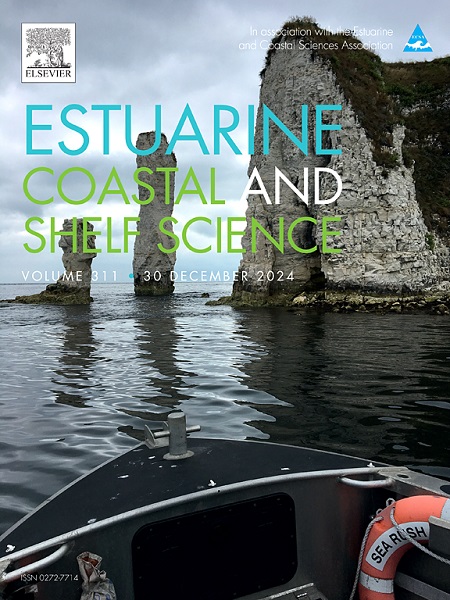Growth and year-class dynamics of the Japanese silver pomfret Pampus punctatissimus: Correlation between salinity and recruitment
IF 2.6
3区 地球科学
Q1 MARINE & FRESHWATER BIOLOGY
引用次数: 0
Abstract
Pampus punctatissimus (Perciformes: Stromateidae) is a semi-anadromous fish that typically inhabits the continental shelf but depends on estuarine environments for reproduction. This species represents an important fishery resource in the Western Pacific. However, critical knowledge gaps remain regarding its population parameters and recruitment dynamics, which are crucial for its stock management. In this study, we aimed to investigate the longevity, growth, and year-class strength via otolith analysis of P. punctatissimus specimens collected from Ariake Bay—a key reproductive area for this species—and its surrounding waters. The validity of age estimation based on whole otoliths differed between sexes and was nearly completely invalid for males. The maximum observed age based on sectioned otoliths was 13 years, exceeding the previously reported maximum age for a congener by a factor of more than two. Growth exhibited significant sexual dimorphism: females reached 3.8 kg, whereas males reached 1.2 kg. Consequently, nearly all specimens weighing more than 1 kg were female. Year-class strength fluctuated significantly, revealing a recruitment failure in 2017. The back-calculated fish length revealed density-dependent growth during the first year of life, implying that stock abundance was limited by the size of nursery habitats. Variations in year-class strength were associated with salinity in the reproductive area, with higher salinity conditions inhibiting recruitment success. The study suggests salinity in reproductive areas as a key driver of recruitment variability in P. punctatissimus, underscoring the need to protect estuarine and nursery habitats for population sustainability.

日本斑鲳鱼的生长和年级动态:盐度与补充的关系
斑鲈(鲈形目:叠层鱼科)是一种半溯河鱼类,通常栖息在大陆架,但繁殖依赖于河口环境。本种是西太平洋重要的渔业资源。然而,关于其种群参数和招募动态的关键知识差距仍然存在,这对其种群管理至关重要。在这项研究中,我们旨在通过耳石分析在有明湾(该物种的主要繁殖区)及其周围水域采集的斑马鱼标本的寿命、生长和年强度。基于整个耳石的年龄估计的有效性因性别而异,对男性几乎完全无效。根据切片耳石观察到的最大年龄为13岁,比先前报道的同类最大年龄高出两倍以上。生长表现出明显的性别二态性:雌性达到3.8公斤,而雄性达到1.2公斤。因此,几乎所有体重超过1公斤的标本都是雌性。年度班级人数大幅波动,表明2017年招聘失败。回溯计算的鱼长揭示了第一年的密度依赖性生长,这意味着种群丰度受苗圃栖息地大小的限制。年级强度的变化与繁殖区的盐度有关,较高的盐度条件抑制了招募成功。该研究表明,繁殖区域的盐度是马斑拟鱼招募变化的关键驱动因素,强调了保护河口和苗圃栖息地以实现种群可持续性的必要性。
本文章由计算机程序翻译,如有差异,请以英文原文为准。
求助全文
约1分钟内获得全文
求助全文
来源期刊
CiteScore
5.60
自引率
7.10%
发文量
374
审稿时长
9 months
期刊介绍:
Estuarine, Coastal and Shelf Science is an international multidisciplinary journal devoted to the analysis of saline water phenomena ranging from the outer edge of the continental shelf to the upper limits of the tidal zone. The journal provides a unique forum, unifying the multidisciplinary approaches to the study of the oceanography of estuaries, coastal zones, and continental shelf seas. It features original research papers, review papers and short communications treating such disciplines as zoology, botany, geology, sedimentology, physical oceanography.

 求助内容:
求助内容: 应助结果提醒方式:
应助结果提醒方式:


